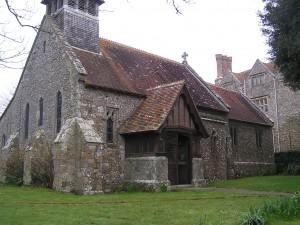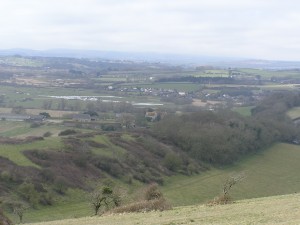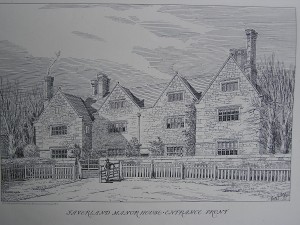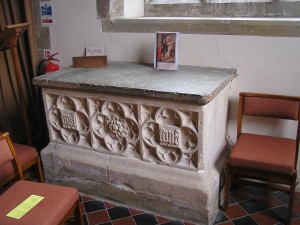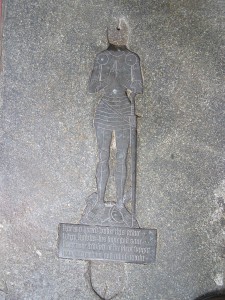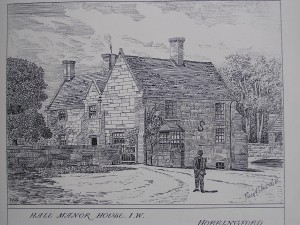The coterie of Norman knights who surrounded Baldwin de Redvers, Earl of Devon and lord of the Isle of Wight, are revealed in the foundation charter for Quarr Abbey, dating from the 1140s. Many were granted estates on the Island and settled there, giving rise to all the most prominent local families of the medieval period. Among them were the Wavells and the Oglanders, who persist on the Island to this day.
Together with Robert d’Orglandes, Godfrey de Wauville and others, a certain Warin de la Halla is mentioned in the charter, having endowed his chapel of St Nicholas to the abbey. He was clearly in favour with Baldwin, from whom he held the lordship of Bampton in Devon, as well as land on the Isle of Wight, south of Carisbrooke Castle.
Warin was ancestor of the ‘De Aula’ family of Yaverland (meaning ‘Overland’ in the Island dialect), in the parish of Brading. As its name suggests, Yaverland was virtually isolated on a spit of land under Bembridge Down. Cut off from the parish church by the tidal Brading Haven, the family built a chapel of ease there, with fine Norman features, alongside their sturdy manor-house of stone.
The male line at Yaverland died out in the reign of Edward I. Eleanor, daughter and heiress of Sir Thomas De Aula, married William Russell, who built the causeway connecting the ‘overland’ with Brading. It was a key moment in the history of East Wight: part of the Haven was thus enclosed, the first step in the process of reclamation that was to be completed in the nineteenth century.
The Yaverland estate was sold by the Hatfields, descendants of the Russells, in 1553, and the manor-house rebuilt, in its present form, in 1620, on the six-foot-wide Norman footings. Mainly of Wight stone under a red-tile roof, it occupies a stupendous position and is one of the finest houses on the Island, a monument in its way to the Norman Conquest of England. The little chapel beside it, built by the De Aulas, is still used for services.
Writing in the seventeenth century, Sir John Oglander says that members of the De Aula family favoured Godshill for burial. Others, no doubt from the main branch, were buried at Brading. The north chapel of Brading Church, reconstructed after a fire in the late-fifteenth or early-sixteenth century, is a monumental chapel to the family and is still known by their name. It contains the tombs of William and Elizabeth de Aula, their name corrupted to ‘Howley’ in the vernacular tongue. ‘Both are altar tombs, bearing the Tudor rose, and are inscribed, in rough sixteenth century letters,
Jhu have merci on Wylyam Howly’s sowl. Amen. MCCCCCXX.
Helizabeth hys Wyf.’
Others of the line settled at Arreton. The manor of Arreton was part of the original endowment to Quarr Abbey and in the parish church, rebuilt by the first monks in the best Norman style, the ‘only remaining pictorial brass is that of Harry Hawles, an honourable member of the ancient De Aula family, who probably held office under Montacute, Earl of Salisbury, Lord of the Island from 1386 to 1397, under grant from Richard II. The head is missing, otherwise the figure is perfect, and is a good example of the period.’
Harry Hawles is thought to have lived at Hale, the small, stone manor-house in the parish that in 1686 was occupied by the descendant of another prominent Norman family. George Oglander had inherited the Oglander name and seal, but was mystified when asked, by visiting heralds, to explain his connection with the Nunwell branch. These people were by then deeply rooted in the soil, bastardising their names, conversing in the local speech and forgetful of their origins. It is a matter of regret that there are no ‘Howleys’ or ‘Hawles’ in the current phone book. One would be surprised, however, if they had not left a fair distribution of female-line descendants among the existing Island population.
In the same way, the Norman colonisers have even infected the local speech. There is a pub at Brading called the Bugle, and another at Newport, which, during the Civil War, was the headquarters of the Parliamentary Commissioners, who included a debased Wavell. In the Island dialect, the word does not mean ‘trumpet’, but ‘steer’. It derives from the Latin word buculus, and is yet another legacy of the Norman Conquest.
(See S.F. Hockey, Quarr Abbey and its Lands, Leicester 1970, pp.7, 10, 257; Percy Stone, The Architectural Antiquities of the Isle of Wight, I, London 1891, pp.7, 15, 69, 87, 120; G.D. Squibb ed., The Visitation of Hampshire and the Isle of Wight, London 1991, p.88; Yaverland Manor Estate, Dreweatt Neate Sale Particulars.)
